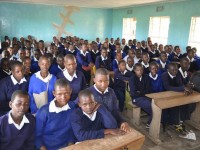Topic: Technical Support to Arusha District, Tanzania
Sponsor: Aga Khan University
Project Duration: 2009-ongoing
Background
Arusha, Tanzania’s second largest city, is strategically located on the transnational transport corridor to Nairobi and lies along the African Rift Valley in one of the most biodiverse regions of the world. It is the starting point for safaris to the Serengeti, Masai Mara and Ngorogoro Crater National Parks. It also hosts a number of international institutions and was recently designated the capital of the East African Community. In addition, both the Aga Khan University and the Nelson Mandela Institute’s African Institute of Science and Technology are building their East Africa campuses on the city’s outskirts.
The ChallengeThe city’s population is projected to double over the next 20 years. This rapid growth has led challenges, including the inadequate provision of water, sanitation, electricity, education and health services to residents, particularly those living outside the downtown area. As land prices escalate, informally developed homes and businesses have built on all available land, leaving little space for roads and emergency access, in addition to making communities vulnerable to floods. Rapid urbanization has also overwhelmed the local authorities’ ability to register property transactions and land development, as well as and collect taxes, which in turns constrains their ability to improve and expand services.
The InitiativeSponsored by the Aga Khan University-East Africa Campus (AKU-EA), I2UD is providing technical support to Arusha’s local authorities to generate an urban management strategy and a development plan to guide the city’s accelerated expansion. Working closely with the Regional Commissioner, the district commissioners, local officials, council members, ward development committees and managers of the water, sewerage, electricity and road authorities, I2UD is preparing the metropolitan urbanization plan, more detailed development plans for strategic sites and project proposals. An implementation plan and a capital improvement budget estimate are being prepared. A brochure outlining the plan’s main features will facilitate the dissemination of information to donors and investors.
Achievements to Date- The Regional Commissioner established a task force to work with I2UD on this project. This is the first time that an interdepartmental senior official group from the three levels of local governance (regional, district, and municipality) has been assembled in Arusha.
- With satellite images of the city purchased by AKU-EA, officials could assess for the first time the extent of development within the municipal boundaries and the spread of informal settlements around the city. These images and the plans generated by I2UD have helped local planning officials visualize growth patterns and tackle issues arising from accelerated urbanization.
- I2UD initiated a participatory planning process and met with all key stakeholders including regional, district and municipal officials; elected representatives to parliament and local councils, ward development committees and village councils.
In a follow-up phase, I2UD will work with 2 communities to design community development centers, a project prioritized by the Task Force, and prepare proposals for which donor funding can be sought.
Back to Projects

